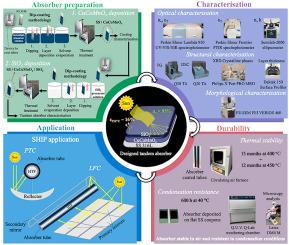用于工业用热的新型高性能串联选择性太阳能吸收器
IF 6.3
2区 材料科学
Q2 ENERGY & FUELS
引用次数: 0
摘要
为了有效过渡到净零碳排放的未来,工业部门需要进行脱碳,而使用小型非真空接收管的工业用热缺乏具有商业竞争力的太阳能吸收器,这促使人们设计一种适合露天条件的新型高稳定性材料。这项研究表明,CuCoMnOx/SiO2串联选择性吸收器是一种潜在的候选材料,其设计目的是为线聚焦接收管涂层,为工业加工热应用提供高达450 °C的热能。值得注意的是,在优化的条件下,仅在不锈钢(SS)上沉积了两层,该材料就表现出了卓越的光学性能,达到了 αs > 0.95 和 ε350°C = 0.16。吸收器的设计将成本效益工业化放在首位,通过优化热处理以降低温度和持续时间,同时微调层厚度以在所需波长上定位光学干扰。这种方法确保了出色的可重复性、均匀性和效率,标志着首次在管状材料上成功沉积涂层。组成吸收器的涂层通过 X 射线衍射、扫描电子显微镜、热重和差示扫描量热计技术进行光学表征。在耐久性方面,吸收器表现出了非凡的韧性,在露天温度为 400-450 °C 的条件下可保持 27 个月的热稳定性,并表现出良好的抗冷凝性(在最恶劣的条件下 PC = 0.03)。因此,SS-基底/CuCoMnOx/SiO2 吸收器成为一种很有前途的商业材料,既适用于抽空式接收管,也适用于非抽空式接收管,从而促进了聚光太阳能发电(CSP)技术与工业用太阳热(SHIP)技术的结合。本文章由计算机程序翻译,如有差异,请以英文原文为准。

Novel highly performing tandem selective solar absorber for industrial heat applications
The needed decarbonisation of the industrial sector for an efficient transition to a Net Zero future, alongside the lack of commercially competitive solar absorbers for industrial heat applications using small non-evacuated receiver tubes, has motivated the design of a new highly stable material suitable for the open-air conditions. This work demonstrates that the potential candidate is the CuCoMnOx/SiO2 tandem selective absorber, designed to coat line-focussed receiver tubes to supply thermal energy up to 450 °C for industrial process heat applications. Remarkably, with only two layers deposited on stainless-steel (SS) under optimised conditions, the material exhibits excellent optical performance, achieving a αs > 0.95 and a ε350°C = 0.16. The absorber design prioritises cost-effective industrialisation by optimising thermal treatment to lower both temperature and duration time, while fine-tuning layer thicknesses to locate optical interferences at the required wavelengths. This approach ensures outstanding reproducibility, uniformity, and efficiency, marking the first successful deposition of coatings on tubular forms. The coatings composing the absorber are characterised optically, by X-ray diffraction, scanning electron microscope, and thermogravimetric and differential scanning calorimeter techniques. In terms of durability, the absorber shows extraordinary resilience, maintaining thermal stability for 27 months at 400–450 °C in open air, and exhibiting good resistance to condensation (PC = 0.03 in the most drastic situation). Therefore, the SS-substrate/CuCoMnOx/SiO2 absorber emerges as a promising commercial material for both evacuated and non-evacuated receiver tubes, promoting the integration of concentrating solar power (CSP) technology with solar heat for industrial processes (SHIP).
求助全文
通过发布文献求助,成功后即可免费获取论文全文。
去求助
来源期刊

Solar Energy Materials and Solar Cells
工程技术-材料科学:综合
CiteScore
12.60
自引率
11.60%
发文量
513
审稿时长
47 days
期刊介绍:
Solar Energy Materials & Solar Cells is intended as a vehicle for the dissemination of research results on materials science and technology related to photovoltaic, photothermal and photoelectrochemical solar energy conversion. Materials science is taken in the broadest possible sense and encompasses physics, chemistry, optics, materials fabrication and analysis for all types of materials.
 求助内容:
求助内容: 应助结果提醒方式:
应助结果提醒方式:


